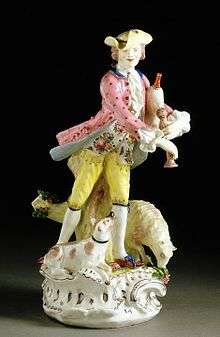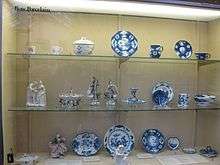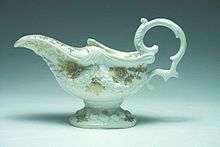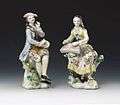Bow porcelain factory

The Bow porcelain factory (active c. 1747–64 and closed in 1776) was an emulative rival of the Chelsea porcelain factory in the manufacture of early soft-paste porcelain in Great Britain. It was originally located near Bow, in what is now the London Borough of Tower Hamlets, but by 1749 it had moved to 'New Canton', sited east of the River Lea.[1] That new site now forms part of the London Borough of Newham, whose Heritage Service owns and curates a significant collection of items from the factory as well as from archaeological digs there in 1969.[2] The New Canton site was also excavated in 1867 (discovering kiln wasters which were tested by a chemist at the direction of Lady Charlotte Schreiber[3]) whilst another dig occurred in 1921 on the opposite side of the High Street.[4]
History
Designs imitated imported Chinese and Japanese porcelains and the wares being produced at Chelsea, at the other end of London. Meissen figures were copied, both directly and indirectly through Chelsea. Quality was notoriously uneven;[5] the warm, creamy body of Bow porcelains is glassy and the glaze tends towards ivory.

Early patents applied for by Thomas Frye and his silent partner Edward Heylyn[6] in December 1744 (enrolled 1745) and a totally different patent of 1 November 1748 (enrolled March 1749), both apparently intended broadly to cover the uses of kaolin,[7] do not seem to have resulted in any actual manufacture before about 1749, though Frye's published epitaph claimed he was "the inventor and first manufacturer of porcelain in England." "Heylyn and Frye do not appear to have had a factory of their own, but probably carried on their experiments at a factory already existing at Bow, having first secured the services of a well-skilled workman whose name has not been preserved, and who may have been the real inventor of English porcelain," a writer noted in 1911.[8]
The earliest Bow porcelains are of soft-paste incorporating bone ash, forming a phosphatic body that was a precursor of bone china. By 1749-1750 the business had moved from Bow to 'New Canton', a new factory on the Essex side of the River Lea, close to Bow Bridge, just west of Stratford High Street and beside Bow Back River. This move is evidenced by inkstands at the British Museum and at the Museum of Royal Worcester bearing the year 1750 and the inscription "Made at New Canton".[9] Also by 1750 Frye was serving as manager of the factory, under new owners, John Crowther and Weatherby. In 1753 they were advertising in Birmingham for painters and a modeller. Sources for the early history of the Bow manufactory were collected by Lady Charlotte Guest in memoranda, diaries, and notebooks, including a diary of John Bowcocke, who was employed in the works as a commercial manager and traveller.
About 1758, the manufactory's high point, 300 persons were employed, 90 of whom were painters, all under one roof. "An account of the business returns for a period of five years shows that the cash receipts, which were £6,573 in 1750–51, increased steadily from year to year, and had reached £11,229 in 1755. The total amount of sales in 1754 realized £18,115."[10] The firm had a retail shop in Cornhill and a warehouse at St Katharine's near the Tower, though a West End shop that was opened in 1757 in the Terrace in St. James's Street closed the following year. The part-owner Weatherby died in 1762 and his partner Crowther was listed as bankrupt the following year. Three sales dispersed his effects in March and May 1764. Though Crowther continued in business in a small way, in 1776 what remained of the Bow factory was sold for a small sum to William Duesbury, and all the moulds and implements were transferred to Derby: see Chelsea porcelain factory.

The chaser and enamellist George Michael Moser, a key figure in the English Rococo and a founder of the Royal Academy, modelled for Bow, the sculptor Joseph Nollekens was told years later;[11] the sculptor John Bacon also modelled for Bow in his youth. The large white figure of the Farnese Flora, a high point in the Bow production, was taken, it has been suggested, from a terracotta by Michael Rysbrack.
A pair of Bow figures of Kitty Clive and Henry Woodward as "the Fine Lady" and 'the Fine Gentleman" in David Garrick's mythological burlesque Lethe, 1750–52 "are probably the earliest full-length portrait figures in English porcelain";[12] some figures bear the incised date 1750, the earliest dates on Bow porcelain.[13] Some were enamelled by William Duesbury.[14] Some Bow figures were imitated from Chelsea models. Bow porcelain adopted the newly invented technique of transfer printing from Battersea enamels in the 1750s.
Gallery
| Wikimedia Commons has media related to Bow porcelain. |
 A Lady Falconer - Bow Porcelain Factory - circa 1755
A Lady Falconer - Bow Porcelain Factory - circa 1755 A Pair of Musicians - Bow Porcelain Factory - circa 1760
A Pair of Musicians - Bow Porcelain Factory - circa 1760 Flora - Bow Porcelain Factory - circa 1762
Flora - Bow Porcelain Factory - circa 1762
Notes
- ↑ Powell, W R, ed. (1973). "'West Ham: Industries', in A History of the County of Essex: Volume 6". British History Online. London: Victoria County History. pp. 76–89. Retrieved 2017-06-26.
- ↑ Site Map of Bow Porcelain Factory, from newhamstory.com
- ↑ Bernard Rackham, Catalogue of English Porcelain, Earthenware, Enamels and Glass collected by Charles Schreiber Esq., M.P., and the Lady Charlotte Elizabeth Schreiber, and presented to the Museum in 1884, Volume I, Porcelain. (London: Victoria and Albert Museum Department of Ceramics, 1928), cited at Fitzwilliam Museum: 'Columbine Dancing'
- ↑ Aubrey J. Toppin, "Bow Porcelain: Some Recent Excavations on the Site of the Factory" The Burlington Magazine for Connoisseurs 40 No. 230 (May 1922), pp. 224 + 228–230 + 233.
- ↑ Charles Truman, reviewing exhibitions of Bow porcelain in The Burlington Magazine 124 No. 952 (July 1982), p. 465; J. V. G. Mallet: "The wares of Bow do not, even in the years of Frye's association with the factory, show much consistency either in design or in execution." Mallet 1984:238.
- ↑ Heylin, a merchant of the parish of Bow and freeholder of the land on which the "china works" were built, appears to have dropped out of active involvement in the venture at an early stage.
- ↑ The first discovery of China stone and china clay in Great Britain were made by William Cookworthy of Plymouth, and appeared in Cookworthy's Plymouth porcelain and Bristol.
- ↑ 'Industries: Pottery: Bow porcelain', A History of the County of Middlesex: Volume 2: General; Ashford, East Bedfont with Hatton, Feltham, Hampton with Hampton Wick, Hanworth, Laleham, Littleton (1911), pp. 146–50. Retrieved 17 May 2007.
- ↑ Bernard Rackham, "The Chronology of Bow Porcelain" The Burlington Magazine for Connoisseurs 25 No. 133 (April 1914, pp. 33–35 + 38–40), p 33.
- ↑ A History..." 1911
- ↑ J.T. Smith, Nollekens and his Times 1828.
- ↑ J.V.G. Mallet in Rococo: Art and Design in Hogarth's England (London: Victorian and Albert Museum) 1984 (exhibition catalogue) O14 p 248.
- ↑ (Rackham 1914:33).
- ↑ Duesbury's London account book, noted by Mallet 1983.
See also
References
- Adam, Elizabeth and David Redstone, Bow Porcelain (London: Faber & Faber Monographs on Pottery & Porcelain) (1981) 1991.(Museum of London Bow porcelain illustrated)
- Bradshaw, Peter Bow Porcelain Figures circa 1748–1774 (London: Barrie & Jenkins) 1992.
- Gabszewicz, Anton, with Geoffrey Freeman. Bow Porcelain, The Collection formed by Geoffrey Freeman (Lund Humphries, 1982)
- Gabszewicz, Anton, Made at New Canton: Bow Porcelain from the Collection of the London Borough of Newham (London: English Ceramic Circle) 2000
- 'Industries: Pottery: Bow porcelain', in: A History of the County of Middlesex: Volume 2: General; Ashford, East Bedfont with Hatton, Feltham, Hampton with Hampton Wick, Hanworth, Laleham, Littleton (1911), pp. 146–50. Retrieved 17 May 2007.
- Mallet, J.V.G. "Rococo in English ceramics" in: Rococo: Art and Design in Hogarth's England (Victoria and Albert Museum), exhibition catalogue 1984.
- Tait, Hugh, "Bow porcelain" in: R.J. Charleston, ed. British Porcelain 1745–1850 (London: Benn) 1965
- Daniels, Pat. " Bow Porceelain 1730–1747. Including the Participation of the Royal Society, Andrew Duche and the American Contribution" 2007. 364 pp. 48 colour and 51 b/w illustrations.
External links
- Industries: Pottery: Bow porcelain, A History of the County of Middlesex: Volume 2: General; Ashford, East Bedfont with Hatton, Feltham, Hampton with Hampton Wick, Hanworth, Laleham, Littleton (1911), pp. 146–50
- Newhamstory.com collection
- Bow Porcelain History, Research, Photos, Talks and Downloads